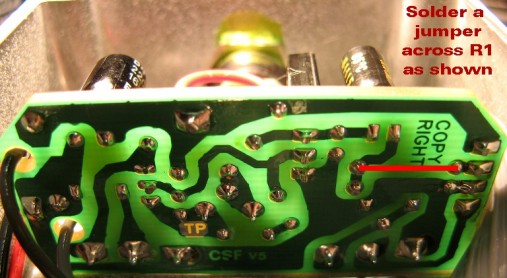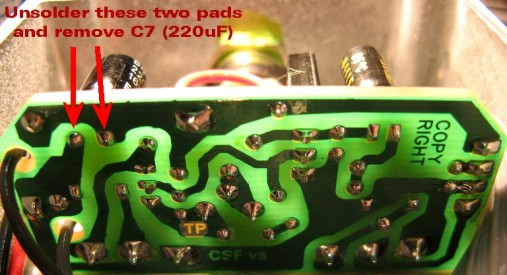The Classic 70’s Fuzz pedal… technical stuff
The CSF is based on the well published “fuzz face” circuit. To follow along with the description, download the PDF of the schematic HERE.
The CSF is a “negative ground” NPN silicon transistor implementation of the fuzz face.
Nearly all of the magic in a fuzz face happens in the transistors. In the CSF both Q1 and Q2 are specially selected Silicon transistors. We spent months auditioning hundreds of transistor types before we found “a pair” that matched perfectly and had the tone we wanted.
Q1 has a gain of around 80, and Q2 has a gain of around 160 giving a nicely responsive fuzz. We did not use the “standard” BC108 transistors because they didn’t sound smooth enough to our ear, plus it is difficult to get consistent supply. The transistors we have selected are readily available and have great tone and touch sensitivity, and they respond excellently to backing off the guitar volume.
Some other points to note in the CSF circuit:
1) An input “trim” resistor (the 10K resistor in the base of Q1) is added primarily to manage the “woofiness” of humbuckers.
2) There is a 100pF from the base of Q1 to ground, plus a 47pF capacitor from the collector to the base of Q2. These are both high-quality mono-block capacitors and they help control RF interference.
3) The “drive” control is a reverse-log pot. This gives much finer control over the amount of fuzz than a linear pot.
4) The Q2 collector resistors and volume pot in the standard fuzz face circuit have been replaced by the “Trim” pot plus the output circuitry of two capacitors, a resistor and the level pot. This is the circuitry that gives the light/dark flavors… Wind back your guitar volume to decrease the dirt and the tone goes stays crisp. Wind back the Drive control on the pedal to decrease the dirt and the tone goes darker and more brooding.
5) The CSF pedal has a set-point/bias control inside mounted on the circuit board (the “Trim” control on the schematic). This has been set in the factory for the optimum “smooth” tone. Please, only adjust this control if you have the necessary skills and experience (if you are in any doubt, please do not attempt adjustment). If you choose to adjust this control:
– Please be aware the trim-pot is fragile. Use an appropriate jeweler’s screwdriver and take care! Any damage to the trim-pot or to any other part of the circuit due to adjusting this control is not covered under warranty.
– Identify the test point on the circuit board (marked “TP”)
– Place the positive probe of a multi-meter set to “Volts” on the test point, and the negative probe on bare metal on the pedal casing (ground). *** Please be very careful to not short anything out during this measurement!
– Adjust the trim-pot until you have the voltage/tone you want. The factory setting is approximately 4.7VDC.
Modding possibilities…
The CSF is an entry-level fuzz so it is a great platform for modding… please note, however, that all mods are done at your own risk, and making any mod to the pedal automatically voids the warranty.
a) The MORE mod – this gives the maximum amount of fuzz available in the pedal. Remove R1 (the 10k base resistor on Q1) from the circuit by jumpering as shown. A more ambitious mod is to unsolder and replace R1 with a 50k pot. Note that removing R1 will increase the noise floor of the pedal.
 |
| . b) The SAG mod. By removing the power smoothing capacitor and using a cheap carbon battery the pedal will sound more vintage (it may take a good pair of ears to hear the difference, but it will be there). A cheap-and-nasty carbon battery is the key. Please see our discussion paper about fuzz-face batteries HERE. |
 |
| .So there you have it. A fuzz face with really nice transistors and some useful upgrades. |
DingoTone field-testing philosophy… DingoTone’s field-test philosophy is to ship between 6 and 10 field-test pedals at the same time to different testers around the world (DingoTone testers live in the USA, Canada, Australia, Ireland, the UK, and the Netherlands). Sending pedals to everyone at once results in almost-real-time interaction between testers. This approach is very expensive (build and ship 6 to 10 pedals for each design iteration, instead of sending a single pedal from one tester to the next), but it results in a higher quality design.






